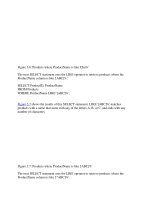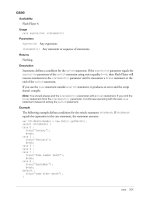Tài liệu Beginning SQL Server Modeling- P3 docx
Bạn đang xem bản rút gọn của tài liệu. Xem và tải ngay bản đầy đủ của tài liệu tại đây (1.24 MB, 20 trang )
CHAPTER 3 DOMAIN-SPECIFIC LANGUAGES 101: LOLA’S LUNCH COUNTER
41
Figure 3-10. Interleaving whitespace
Lola: “So, you’re pretty much back to where you started. I need something that’s going to work with
more than pastrami on rye! How are you going to get there from here?”
Norm: “Right. So how do you define a sandwich, anyway? At the simplest level, it’s some kind of
lunchmeat on some kind of bread. So let’s change the main syntax definition to something like that.”
Norm changes the DSL Grammar code to reflect his thinking, along the lines shown in Figure 3-11.
Of course, the grammar processor (center pane) has no idea what the terms Lunchmeat and Bread are
because they are undefined.
Defining Tokens
Figure 3-11. First cut at making the SandwichOrders syntax rule more general
Norm has redefined the Main syntax, but now he needs to define Lunchmeat and Bread as tokens. To
get started, he’d like the processor to accept any string for Lunchmeat, followed by the preposition "on",
and any string for Bread, with a period at the end. Right now, anything from “foo on bar” to “Brecht on
Brecht” would mean some progress in Lola’s eyes. So Norm adds a couple of token statements to the
grammar definition to define Lunchmeat and Bread as tokens within the grammar that can contain any
sequence of characters.
Figure 3-12 shows the result. Again, the grammar works with this and shows no error. The two token
statements define Lunchmeat and Bread in exactly the same way: They can be a single contiguous string of
Download from Wow! eBook <www.wowebook.com>
CHAPTER 3 DOMAIN-SPECIFIC LANGUAGES 101: LOLA’S LUNCH COUNTER
42
one or more characters, a through z or A through Z. But I’ve introduced a number of new M language
forms:
"a".."z"” means a single alpha character anywhere in the range from a to z. Similarly, "A".."Z"
means a single capitalized alpha character anywhere in the range from A to Z.
A pipe character (|) is the logical OR operator.
A plus sign (+) is a postfix Kleene operator, meaning “one or more of this entity.”
So given this syntax, ("a".."z" | "A".."Z")+ means “any sequence of one or more alpha
characters, upper- or lowercase.” So Rye and rAzzLeDaZZle both qualify, and rAzzLeDaZZle on Rye
would be a valid sandwich order, according to the newly defined DSL Grammar code. This removes one
of the constraints of the extremely limited Pastrami on Rye straight jacket, but you’re still a long way
from anything resembling a useful sandwich order system.
Figure 3-12. Defining the Lunchmeat and Bread tokens as arbitrary strings
Enabling Multiple DSL Statements
Lola: “Okay, say I just had another customer order a ham on 9-grain wheat sandwich. Will your
system handle that?”
Norm: “I don’t think so, but let’s try it and see where it breaks.”
Figure 3-13 shows the results of adding the ham on 9-grain order.
Download from Wow! eBook <www.wowebook.com>
CHAPTER 3 DOMAIN-SPECIFIC LANGUAGES 101: LOLA’S LUNCH COUNTER
43
Figure 3-13. Errors generated by adding a second sandwich order in the DSL
The Error List pane indicates that a carriage return and line feed were unexpected, so you need to
add these to the Whitespace rule.
Lola: “But why the first error in the list? Doesn’t that order conform to the syntax you’ve defined?”
Norm: “In a sense, yes. The new statement itself conforms to the grammar, but the syntax really is
valid for only one statement.”
Figure 3-14. One remaining error after carriage return, and new-line are added to ignorable whitespace
In Figure 3-14, Norm has added the carriage return (the UTF8 encoding for this is written as "\r")
and new line (written as "\n") to the interleave rule. After this, the only remaining error is the
unexpected Lunchmeat token, which is really caused by the unexpected second order statement. To fix
this problem, Norm encloses the Main syntax phrase on the right side of the equals sign (=) in
parentheses and adds a postfix + to indicate that one or more instances of the conforming statement are
expected (Figure 3-15). [Similar operators, called Kleene operators, are an asterisk (*) to indicate zero or
more occurrences, and question mark (?) to indicate zero or one occurrence.]
Download from Wow! eBook <www.wowebook.com>
CHAPTER 3 DOMAIN-SPECIFIC LANGUAGES 101: LOLA’S LUNCH COUNTER
44
Figure 3-15. Testing for unanticipated characters in the Bread token definition
Modifying the Main rule to allow for multiple orders still leaves you with two errors in the Error List
pane: the 9 and hyphen (-)characters are unexpected. So for the time being, Norm adds the numeric
characters 0 through 9 and the hyphen character to the Bread token definition, as shown in Figure 3-16.
Figure 3-16. Multiple orders now valid after modifying the Main syntax rule
Download from Wow! eBook <www.wowebook.com>
CHAPTER 3 DOMAIN-SPECIFIC LANGUAGES 101: LOLA’S LUNCH COUNTER
45
Tightening Up the Syntax
No errors here, so you’re good so far. It looks like the processor will accept, generally speaking, any kind
of sandwich order that conforms to the pattern <some alpha string> "on" <some alpha string>. The
two strings can even be the same, like
Blue on Blue.
This would be valid under the current syntax definition.
Lola: “So, Norm, let’s cut to the chase here. I’m not impressed with this system so far. Some wing
nut could walk in and order “blue on blue,” and the server wouldn’t know whether to go to the jukebox
or the order screen.
Lola types in “Blue on Blue.” as a new sandwich order (Figure 3-17).
Figure 3-17. A syntax too ill-defined
Norm: “Exactly right, Lola—you catch on fast. Let’s see if I can tighten up the language definition to
do two things: 1) Provide a way of syntactically identifying which is the Lunchmeat and which is the Bread
in a SandwichOrders statement, and 2) Provide a mapping of the components of a SandwichOrders
statement to a database table. You want the system to allow an order for pastrami on rye, but reject an
order for rye on pastrami. And, of course, the Blue on Blue problem should no longer happen.
Lola: “Fine.”
Moving Toward Structured Data
The first thing Norm does is to change the Main syntax rule to define it as a collection of one or more
SandwichOrders. This will result in creating a collection in the M Graph code, which would map to what
is called an extent. Extents correspond to tables within the database, once the model is deployed to SQL
Download from Wow! eBook <www.wowebook.com>
CHAPTER 3 DOMAIN-SPECIFIC LANGUAGES 101: LOLA’S LUNCH COUNTER
46
Server. When the image file generated by the M compiler is installed in the Repository database, this
would result in a table of SandwichOrders. (For now, think of repository as a fancy word for database.)
Figure 3-18 shows the results of the first of these changes.
Figure 3-18. Changing the Main syntax role and adding the SandwichOrder syntax rule
You still have the Blue on Blue problem, but in the generated M Graph you are identifying the
Lunchmeat and Bread data components, even if there are no semantic constraints on these.
Let’s walk through the structure of the code of the DSL Grammar definition (center panel). At the
highest level (outermost curly braces), you have the LunchCounter module, which defines your
namespace. Within the module, you have a single language definition, named SandwichOrders. The
language definition (contained within the next set of curly braces) consists of a collection of syntax rules,
token rules, and an interleave rule (discussed in the section titled “Defining Tokens”).
The Main syntax rule:
syntax Main = SandwichOrder*
sets the Main syntax rule to be a collection of zero or more SandwichOrders. (Recall that the asterisk * is a
multiplicity operator designating a collection of zero or more instances.)
The SandwichOrder syntax rule:
syntax SandwichOrder = lm:Lunchmeat "on" br:Bread "."
=> {Lunchmeat => lm, Bread => br}
is really the heart of the SandwichOrders language definition. This construction says two things. A
SandwichOrder consists of a Lunchmeat token, given the identifier lm, followed by the literal "on", followed
by a Bread token given the identifier br, followed by the period character ".". => is the binding operator,
so the second line of the preceding code syntax rule statement means that the construction results in an
entity with two members: a Lunchmeat token with the value lm and a Bread token with the value br.
Entities are simply collections with named values, so here you’re defining an entity with two values: a
Lunchmeat value (bound to the identifier lm) and a Bread value (bound to the identifier br).
Download from Wow! eBook <www.wowebook.com>
CHAPTER 3 DOMAIN-SPECIFIC LANGUAGES 101: LOLA’S LUNCH COUNTER
47
Next, Norm again refines the Main syntax rule to store the collection of SandwichOrders in an extent
named SandwichOrders. You see the results in Figure 3-19. What you see in the M Graph pane shows that
you’re getting a little closer to what you might call structured data.
Figure 3-19. Generating the SandwichOrders collection with restructured syntax rules
Lola: “Okay Norm—one step forward, and one back. I can see you’re making some progress in
getting to where the system knows its lunchmeat from its bread. Not to complicate things too much, but
do you think you could add in condiments, like mayo or mustard?”
Norm: “Sure thing. As usual, I’ll add an order with a condiment and see how this breaks the DSL
grammar definition. Type an order with a condiment, and I’ll see what kind of error you get.”
Lola types: “Ham on Baguette with Mayo.” Figure 3-20 shows the results.
Figure 3-20. Testing a condiment addition
Norm has clicked on the single error description in the Error List pane, and this has highlighted the
DSL segment "with" after the Bread token, the cause of this particular error.
Download from Wow! eBook <www.wowebook.com>
CHAPTER 3 DOMAIN-SPECIFIC LANGUAGES 101: LOLA’S LUNCH COUNTER
48
Norm: “Well, clearly you’ve broken the grammar definition in at least a couple of ways, since it is no
longer generating M Graph output in the right pane. From what you see in the error list, it thinks the
word “with” is a Lunchmeat token. Here’s what I’d suggest. Let’s not add condiments into the system for
the time being, and instead focus on refining the Lunchmeat and Bread syntax so that you get rid of the
Blue on Blue problem, and the system is smart enough to exclude nonsense orders like ham on
pastrami, even though ham and pastrami are both valid token values.
Lola: “Makes sense. One thing at a time.”
Norm changes the token definitions for Lunchmeat and Bread to be collections of a few of the
sandwich makings that comprise some sandwiches on Lola’s menu. And he removes the condiment
fragment from the last order to keep things simple. Figure 3-21 shows the result.
Figure 3-21. Redefining the Lunchmeat and Bread tokens
Redefining the syntax in this way, where only valid names are given for the Lunchmeat and Bread
tokens in the grammar definition, has trapped nonsense orders like Blue on Blue.
Testing the Syntax
Lola: “Good—this is looking much more specific now. But let’s check something. What will it do with an
order like ham on pastrami?”
Norm: “Okay, here it is.”
Norm enters the order “Ham on Pastrami.” in the DSL pane, with the resulting error shown in
Figure 3-22.
Download from Wow! eBook <www.wowebook.com>









